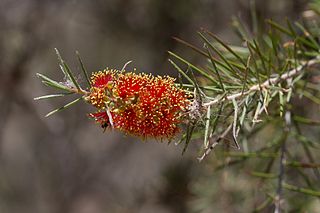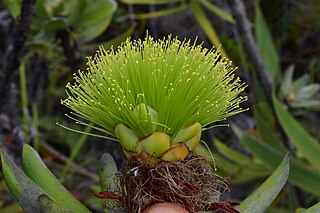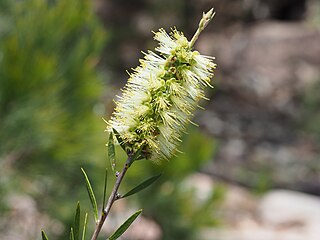
Melaleuca pityoides, commonly known as alpine bottlebrush, is a plant in the family Myrtaceae, and is endemic to the higher areas of south eastern Australia. Some Australian state herbaria continue to use the name Callistemon pityoides. It is a shrub, often occurring in dense thickets, with hard bark, silvery-grey new growth, almost cylindrical leaves and spikes of flowers that are usually a shade of yellow.

Melaleuca williamsii is a plant in the myrtle family, Myrtaceae and is endemic to an area between north-eastern New South Wales and south eastern Queensland in Australia. It is a distinctive shrub with stiff branches, silvery new growth, prickly leaves and spikes of purple flowers in late spring. It is classified as a vulnerable species under the Australian Government Endangered Species Protection Act.

Melaleuca orophila, commonly known as needle bottlebrush or Flinders Ranges bottlebrush, is a plant in the myrtle family, Myrtaceae and is endemic to the eastern part of South Australia.. It is a medium-sized shrub with sharp-pointed, needle-like leaves and bright red bottlebrush flower spikes.

Melaleuca brachyandra, commonly known as prickly bottlebrush or scarlet bottlebrush, is a plant in the myrtle family, Myrtaceae and is endemic to New South Wales, Victoria and South Australia in Australia. It is a shrub or small tree with narrow leaves and showy red and green flowers making it an ideal ornamental plant in temperate areas.

Melaleuca pallida, commonly known as lemon bottlebrush, is a plant in the myrtle family, Myrtaceae and is endemic to eastern Australia. It is an upright shrub with thin, spreading branches, silvery new growth and pale yellow, sometimes pinkish bottlebrush flowers.

Pleurocalyptus is a group of shrubs and small trees in the family Myrtaceae, first described as a genus in 1868. The entire genus is endemic to New Caledonia. It is closely related to Xanthostemon.
Melaleuca brevisepala is a shrub in the myrtle family, Myrtaceae and is endemic to the north-west of Grande Terre, the main island of New Caledonia where it is known from only a few locations. It is one of only a few members of its genus to occur outside Australia.
Melaleuca buseana is a shrub or small tree in the myrtle family, Myrtaceae, and is endemic to the south of Grande Terre, the main island of New Caledonia. It is one of only a few members of its genus to occur outside Australia and was formerly known as Callistemon buseanus.

Melaleuca dawsonii is a shrub in the myrtle family, Myrtaceae and is endemic to the south of Grande Terre, the main island of New Caledonia. It is one of only a few members of its genus to occur outside Australia and was formerly known as Callistemon suberosum Pancher ex Brongn. & Gris.
Melaleuca sphaerodendra is a plant in the myrtle family Myrtaceae, and is endemic to Grande Terre, the main island of New Caledonia. It is one of only a few members of its genus to occur outside Australia and was previously known as Callistemon gnidioides Guillaumin.
Melaleuca brongniartii is a shrub in the myrtle family, Myrtaceae and is endemic to the south of Grande Terre, the main island of New Caledonia. It is one of only a few members of its genus to occur outside Australia.
Melaleuca gnidioides is a shrub in the myrtle family Myrtaceae and is endemic to the south of Grande Terre, the main island of New Caledonia. It is one of only a few members of its genus to occur outside Australia and is a small shrub with heads of white flowers which turn pink with age.

Melaleuca flammea, commonly known as tapering-leaved bottlebrush, is a plant in the myrtle family, Myrtaceae and is endemic to New South Wales and Queensland in Australia. It is a shrub with broad, lance-shaped leaves which have wavy edges and taper gradually to a fine point. In spring it has typical bottlebrush flowers whose fiery colour gives the species its name.

Melaleuca flavovirens, commonly known as green bottlebrush is a plant in the myrtle family, Myrtaceae and is endemic to a small area near the New South Wales–Queensland border in Australia. It is a stiff shrub, distinguished by its silvery new growth and spikes of greenish flowers with yellow tips.

Melaleuca glauca, commonly known as Albany bottlebrush is a plant in the myrtle family, Myrtaceae and is endemic to the south-west of Western Australia. It is a tall shrub with glaucous leaves and spikes of red flowers in spring.

Melaleuca montana, commonly known as mountain bottlebrush, is a plant in the myrtle family, Myrtaceae and is endemic to the Border Ranges area of New South Wales and Queensland in Australia.. It is a shrub or small tree distinguished from most other red bottlebrushes by its hairy petals.
Melaleuca montis-zamia is a plant in the myrtle family, Myrtaceae and is endemic to the Springsure district in Queensland, Australia. It is a shrub with red bottlebrush flowers.
Melaleuca phratra is a plant in the myrtle family, Myrtaceae and is endemic to Queensland in Australia. It is a large shrub similar to Melaleuca paludicola but has flower spikes that are a shade of pink.

Melaleuca serpentina is a plant in the myrtle family, Myrtaceae and is endemic to the Barraba district in Australia. It is a shrub with yellow or creamy-green bottlebrush flowers. It is similar to Melaleuca citrina but can be distinguished from that species by its flower colour and its shorter stamens.

Melaleuca wimmerensis, commonly known as the Wimmera bottlebrush, is a plant in the myrtle family, Myrtaceae and is endemic to the state of Victoria in Australia.. It is a recently (2008) discovered shrub, often with many stems arising from a lignotuber and is similar to Melaleuca paludicola but has pink or mauve flowers tipped with yellow anthers over a short period between October and early December.













